Experimental Study on Simulated Acoustic Characteristics of Downhole Tubing Leakage
Abstract
1. Introduction
2. Experimental Study on Tubing Leakage Detection
2.1. Casing Leakage Simulation Experimental System
- High gas supply demand: Full-scale tubing requires substantial gas reserves, making flow stability difficult to maintain, which significantly interferes with leakage acoustic signals.
- Submerged leakage simulation challenges: Conditions with leakage points below liquid levels are poorly replicated.
- Leakage orifice control issues: Precise positioning and sizing of leakage holes are hard to achieve, and frequent replacements are impractical.
- Safety risks: High-pressure gas leakage experiments pose hazards, and repeated pipe disassembly compromises sealing integrity at connections.
- (1)
- Start the air compressor and shut it down when the buffer tank pressure reaches 0.7 MPa, preventing motor noise interference during compression from affecting the leakage acoustic experiments;
- (2)
- Open the pipeline valve between the buffer tank and the simulated wellbore, then activate the filter pressure regulator and set the output pressure to 0.5 MPa. Turn on the gas flow controller and set the output flow rate;
- (3)
- For leak-free experiments, ambient noise serves as the system background noise;
- (4)
- For tubing leakage experiments, compressed air flows from the buffer tank through the pipeline, sequentially passing through the desiccant filter, filter pressure regulator, gas flow controller, and finally jets into the annulus through the tubing leakage orifice.
2.2. Experimental Program
- (I)
- Experimental Objectives and Content
- Objectives: Investigate the acoustic characteristics of tubing leakage in the annulus under various conditions.
- Content: Based on leakage scenarios, the study focuses on five aspects:
- ①
- Leakage rate: Impact on acoustic characteristics.
- ②
- Leakage aperture size: Influence on acoustic signatures.
- ③
- Leakage depth: Effect on sound wave propagation.
- ④
- Number of leakage points: Relationship with acoustic response.
- ⑤
- Leakage position: Comparative analysis of leaks above vs. below the liquid level.
- (II)
- Experimental Procedure
3. Acoustic Source Characteristics of Tubing Leakage
3.1. Influence of Leakage Flow Rate on Acoustic Characteristics
3.2. Influence of Leakage Aperture on Acoustic Characteristics
3.3. Influence of Leakage Depth on Acoustic Characteristics
3.4. Effect of Leakage Point Quantity on Acoustic Wave Characteristics
3.5. Comparative Analysis of Leakage Acoustic Waves Above and Below Liquid Level
4. Conclusions
- (1)
- Tubing gas leakage generates broadband noise, with high-frequency energy levels increasing proportionally to either higher flow rates or smaller aperture sizes. The acoustic sources primarily comprise quadrupole and dipole components.
- (2)
- For multi-point leakage, neither time–frequency amplitudes nor total sound pressure levels (SPL) exhibit a strict positive correlation with the leak quantity. Acoustic wave superposition between multiple sources may amplify or attenuate overall noise energy.
- (3)
- Sub-surface leaks (below the liquid level) demonstrate fundamentally distinct acoustic signatures compared to above-surface leaks:
- Time–domain: Pulsating impact signals caused by discontinuous gas migration through liquid, inducing surface turbulence and bubble rupture upon reaching the interface.
- Frequency–domain: Energy concentration within 0–1000 Hz due to severe high-frequency attenuation across the gas–liquid interface (acoustic impedance mismatch), while low-frequency components persist.
- (4)
- Simultaneous leaks above and below the liquid level produce hybrid acoustic features distinguishable from above-surface-only scenarios. Critically, any sub-surface leakage—whether isolated or combined—significantly alters both time–domain pulsation patterns and frequency-bandwidth distributions in annular acoustic signals.
- (5)
- Limitations and challenges in field applications: This study focuses on the acoustic characteristics of gas leakage under low-pressure conditions (i.e., pressure levels that induce phase transitions). If phase transitions occur during a gas leakage, more complex acoustic signals may be generated. For instance, in the case of tubing leakage in CO2 injection wells, leaked CO2 entering the annulus space may undergo phase transitions. Further research on the acoustic characteristics of downhole CO2 leakage under varying pressure conditions is recommended.
Author Contributions
Funding
Data Availability Statement
Conflicts of Interest
Abbreviations
| SCP | sustained casing pressure |
| SPL | sound pressure level |
| SLPM | standard liter per minute |
References
- Ma, F.; Fan, J.; Yang, Y.; Ding, J.; Fang, Y. Gas Leakage Acoustic Wave Detection Below the Liquid Level of Oil Pipe in Gas Wells Based on Convolutional Neural Network. J. Appl. Acoust. 2024, 43, 765–774. [Google Scholar]
- Fang, Y.; Fan, J.; Yang, Y.; Ma, F. Simulation of the Sound Field for Leakage Below the Annular Liquid Level in Gas Wells. China Pet. Mach. 2024, 52, 64–69. [Google Scholar]
- Wan, Z.; Zhang, Z.; Liu, L.; Dou, Y. Current status and development of ground detection techniques for oil casing leaks. Unconv. Oil Gas 2025, 12, 1–10. [Google Scholar]
- He, H. Reliability Evaluation Method and Application of Oil and Gas Well Shaft System. Saf. Sci. Technol. China 2018, 14, 6. [Google Scholar]
- Yang, S.; He, H.; Zhang, Z.; Dou, X.; Yin, X. Research on a Multifunctional Annular Space Pressurized Ground Diagnosis Method and Device. J. Southwest Pet. Univ. Nat. Sci. Ed. 2023, 45, 131–139. [Google Scholar]
- He, H.; Yang, S.; Dou, N.; Dou, X. Research Status and Progress of Ground Detection Technology for Oil and Casing Leakage. China Equip. Eng. 2022, 6, 173–174. [Google Scholar]
- Liang, Z. Analysis of Underground Oil and Casing Leakage Signals Based on Hilbert-Huang Transform. Master’s Thesis, China University of Petroleum, Beijing, China, 2018. [Google Scholar]
- Bi, R.; Guo, M.; Wang, S.; Zhang, Y.; Si, X.; Chen, X.; Zhang, L. Theories, Techniques and Materials for Sealing Coalbed Methane Extraction Boreholes in Underground Mines: A Review. Processes 2024, 12, 2022. [Google Scholar] [CrossRef]
- Lee, J.H.; Kim, Y.; Kim, I.; Hong, S.B.; Yun, H.S. Comparative Analysis of Ultrasonic and Traditional Gas-Leak Detection Systems in the Process Industries: A Monte Carlo Approach. Processes 2023, 12, 67. [Google Scholar] [CrossRef]
- Shan, H.; Zhu, Y. Gas pipeline leakage detection method based on IUPLCD and GS-TBSVM. Processes 2023, 11, 278. [Google Scholar] [CrossRef]
- Mujtaba, S.M.; Lemma, T.A.; Taqvi, S.A.A.; Ofei, T.N.; Vandrangi, S.K. Leak detection in gas mixture pipelines under transient conditions using Hammerstein model and adaptive thresholds. Processes 2020, 8, 474. [Google Scholar] [CrossRef]
- Zhou, M.; Zhang, Q.; Liu, Y.; Sun, X.; Cai, Y.; Pan, H. An integration method using kernel principal component analysis and cascade support vector data description for pipeline leak detection with multiple operating modes. Processes 2019, 7, 648. [Google Scholar] [CrossRef]
- Johns, J.E.; Blount, C.G.; Dethlefs, J.C.; Loveland, M.J.; McConnell, M.L.; Schwartz, G.L.; Julian, J.Y. Applied ultrasonic technology in wellbore-leak detection and case histories in Alaska North Slope wells. SPE Prod. Oper. 2008, 24, 225–232. [Google Scholar]
- Martinez, R.; Hill, A.D. Diagnosis of fracture flow conditions with acoustic sensing. In Proceedings of the SPE Hydraulic Fracturing Technology Conference, The Woodlands, TX, USA, 6–8 February 2014; ISBN 978-1-61399-310-1. [Google Scholar]
- Bateman, R.M. Cased-Hole Log Analysis and Reservoir Performance Monitoring; Springer: New York, NY, USA, 2015. [Google Scholar] [CrossRef]
- Jalan, S.N.; Ai-Haddad, S.; Ali, S.M.; Al-Hamli, D.; Prosvirkin, S.; Aristov, S. Application of noise and high precision temperature logging technology to detect tubing leak in an oil well-a case study. In Proceedings of the SPE Kuwait Oil and Gas Show and Conference, Kuwait City, Kuwait, 15–18 October 2017. [Google Scholar] [CrossRef]
- Dong, Z. Jet Mechanics; Science Press: Beijing, China, 2005. [Google Scholar]
- Ho, C.M.; Nosseir, N.S. Dynamics of an impinging jet. Part 1. The feedback phenomenon. J. Fluid Mech. 1981, 105, 119–142. [Google Scholar] [CrossRef]
- Ge, Q.; Yao, Z.; Cui, Y.; He, F. Experimental study on the noise characteristics of impinging jets with concave-convex plates. J. Tsinghua Univ. 2005, 5, 681–684. [Google Scholar]
- Wang, Q. Study on Source Characteristics and Testing Technology Experiment of Jacketed Structure Inner Pipe Leakage. Master’s. Thesis, Northeast Petroleum University, Daqing, China, 2014. [Google Scholar]
- Liu, Y. Study on Source Characteristics and Testing Technology Experiment of Jacketed Structure Inner Pipe Leakage. Ph.D. Thesis, Northeast Petroleum University, Daqing, China, 2016. [Google Scholar]
- Liu, D.; Fan, J.; Liu, S.; Wang, C.; Liang, Z.; Fan, Z. Experimental Research on the Location of Multiple Leaks in Downhole Tubing of Gas Wells. China Saf. Sci. J. 2018, 14, 6. [Google Scholar]
- Budenkov, G.A.; Nedzvetskaya, O.V.; Strizhak, V.A. Acoustics of the annular space of producing and injection wells. Russ. J. Nondestruct. Test. 2004, 39, 571–576. [Google Scholar] [CrossRef]
- Rodrigues, S.S.; Marta, A.C. On addressing noise constraints in the design of wind turbine blades. Struct. Multidiscip. Optim. 2014, 50, 489–503. [Google Scholar] [CrossRef]
- Huang, Y.M.; Chen, T.C.; Shieh, P.S. Analytical estimation of the noise due to a rotating shaft. Appl. Acoust. 2014, 76, 187–196. [Google Scholar] [CrossRef]

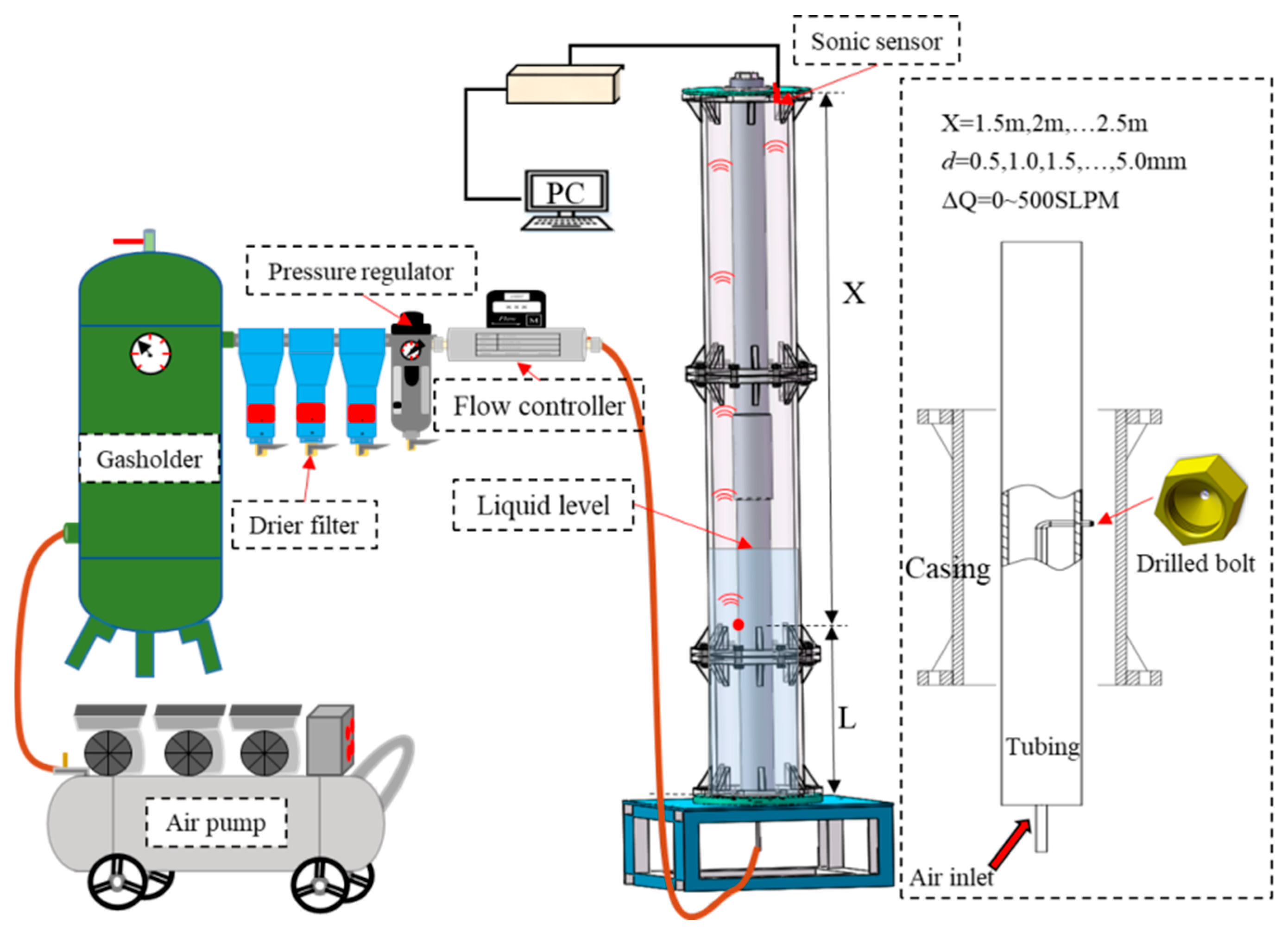
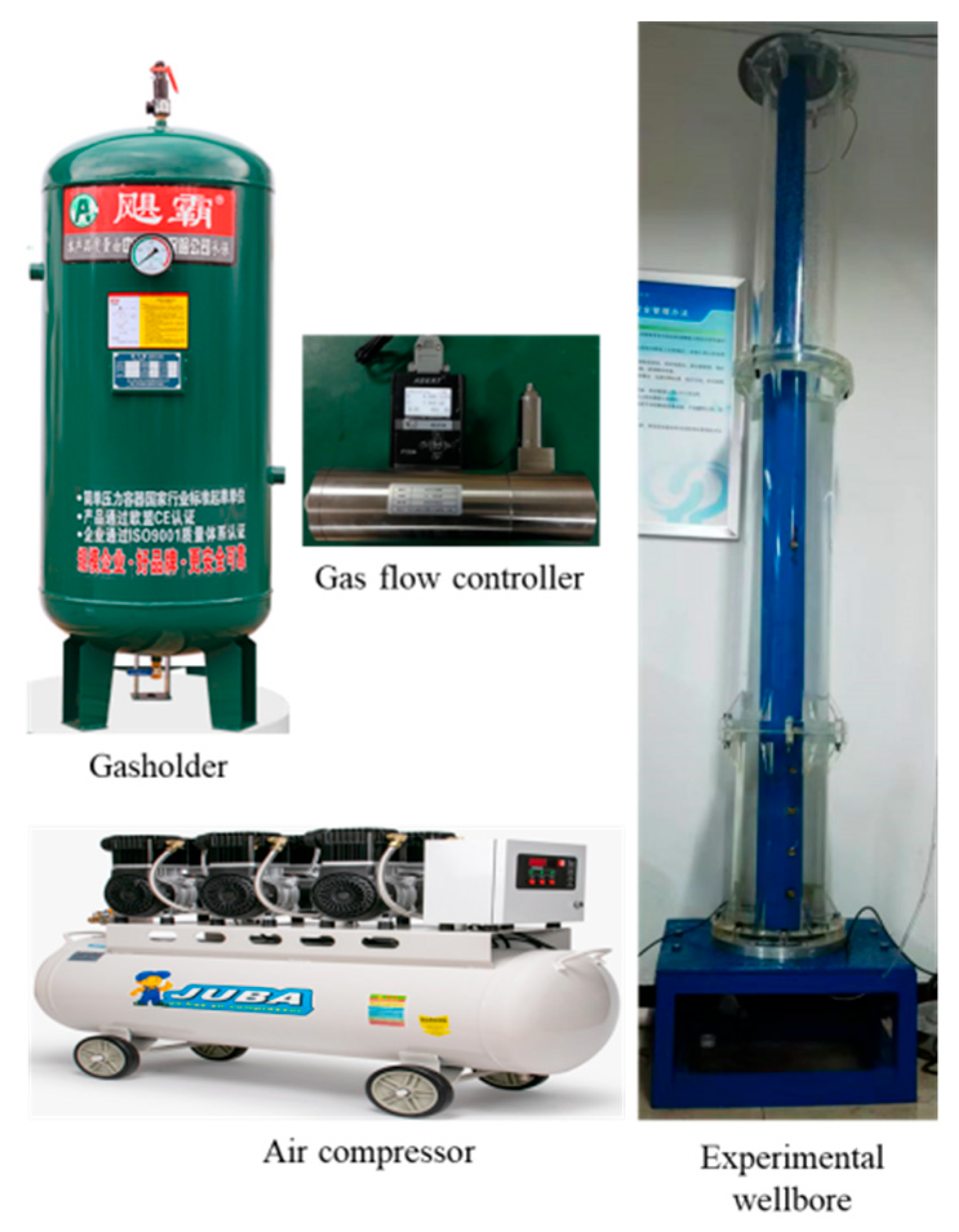

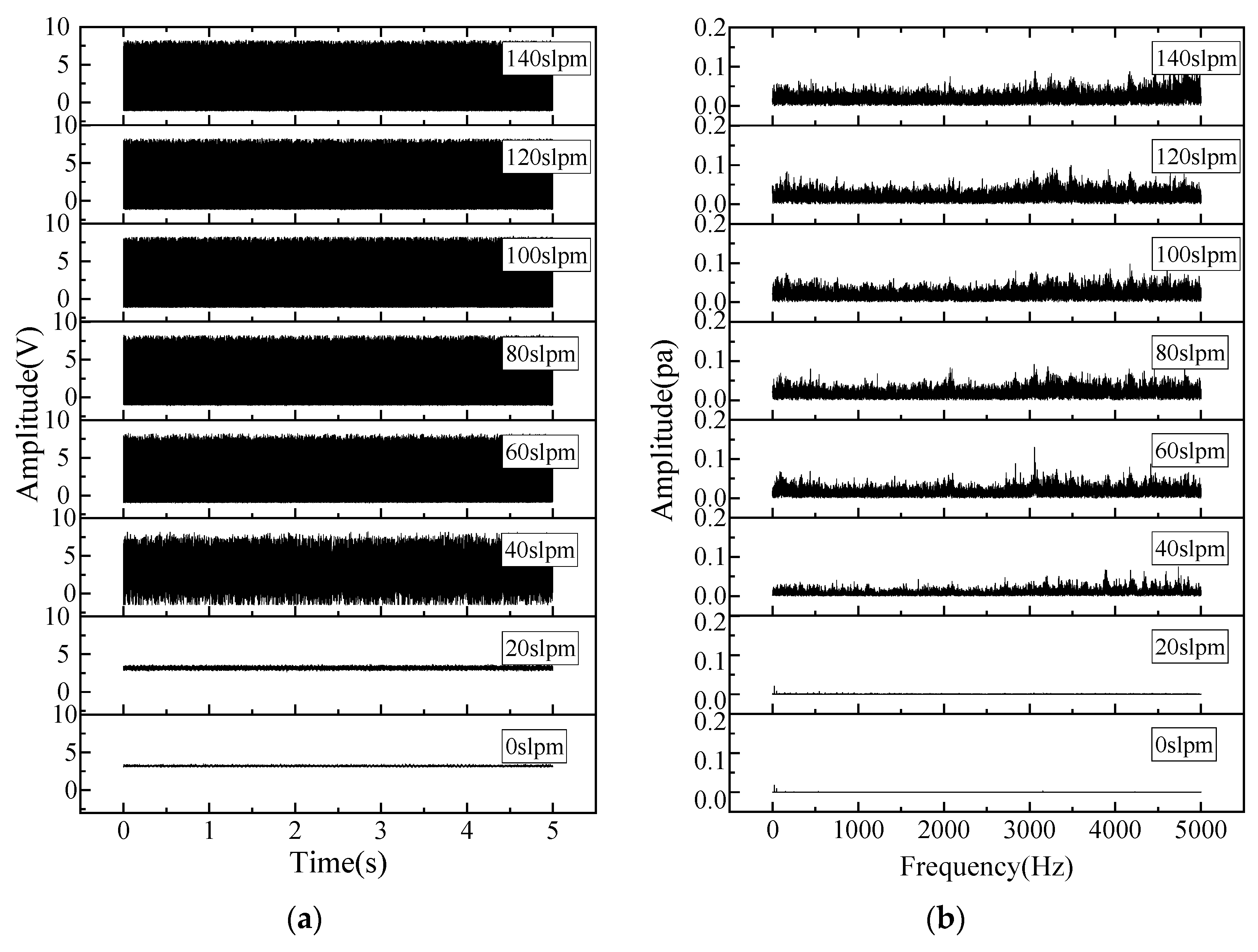
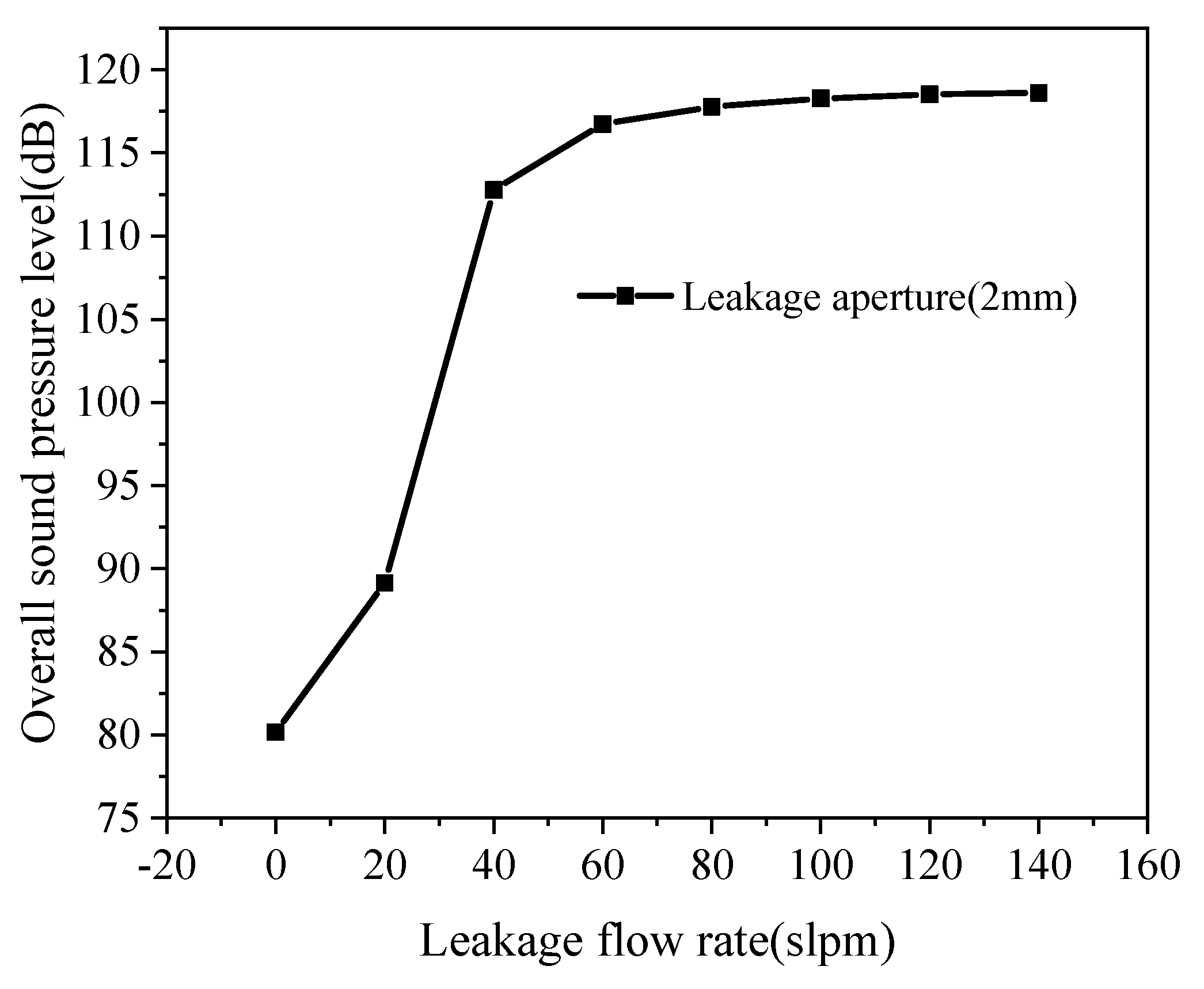

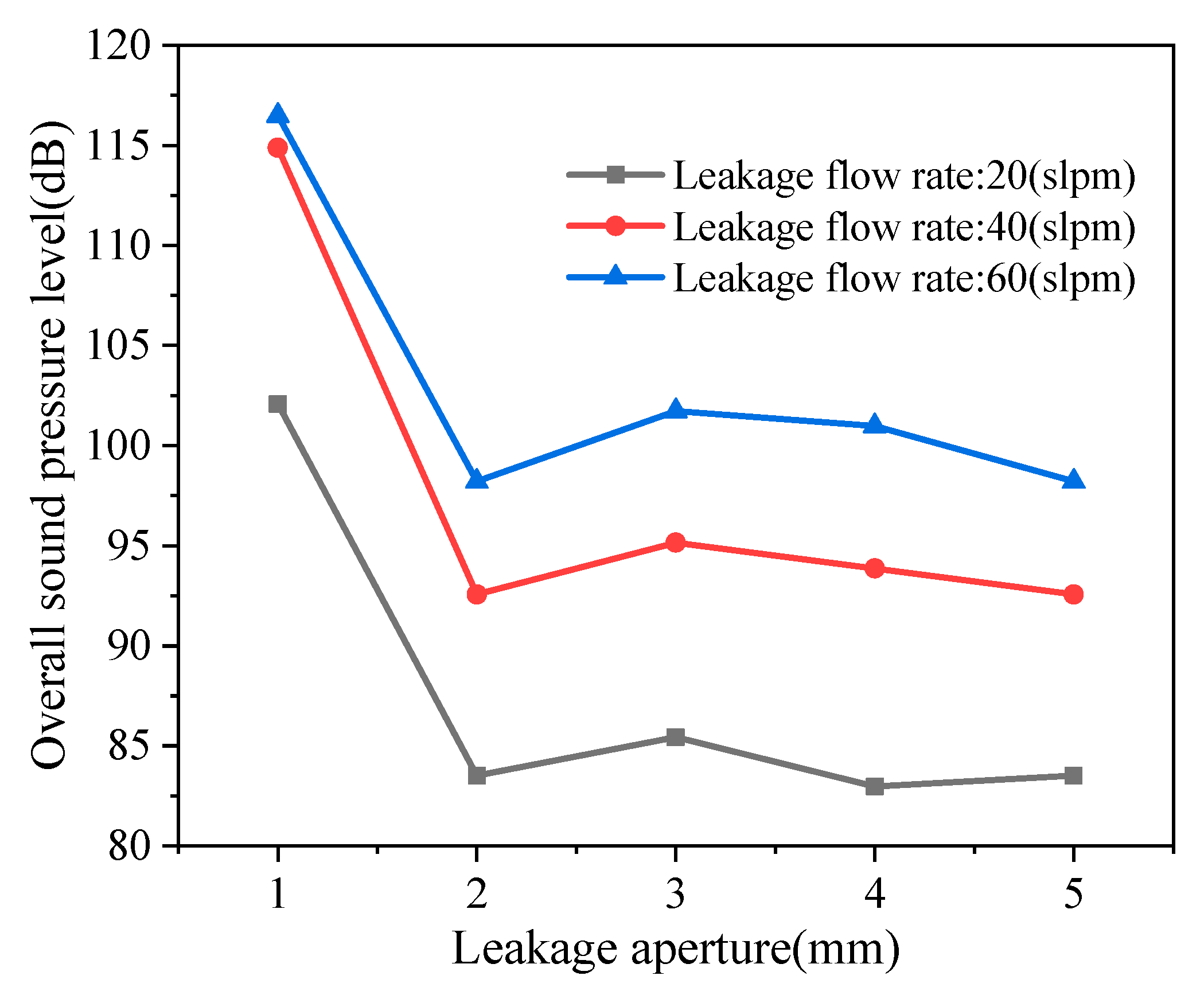
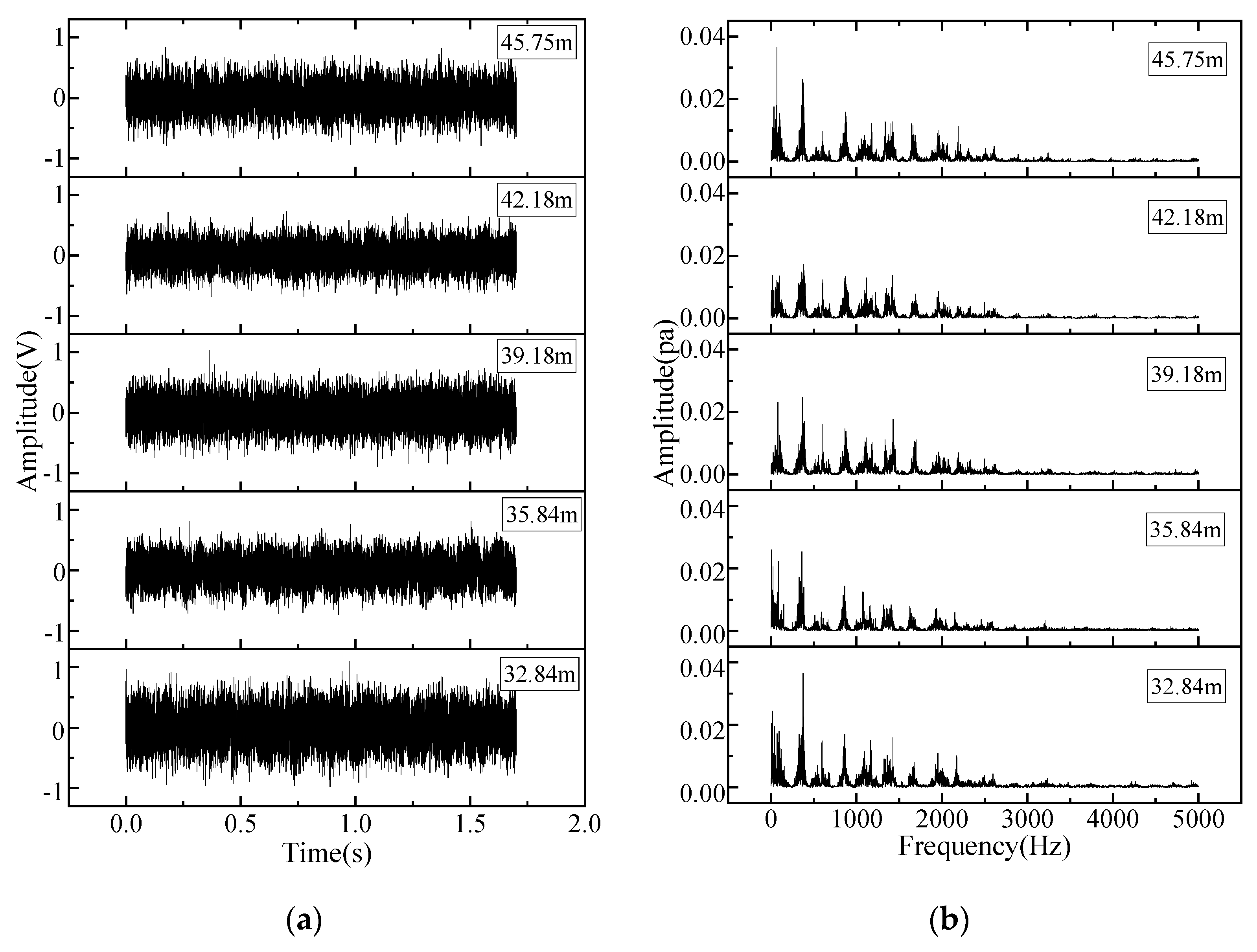




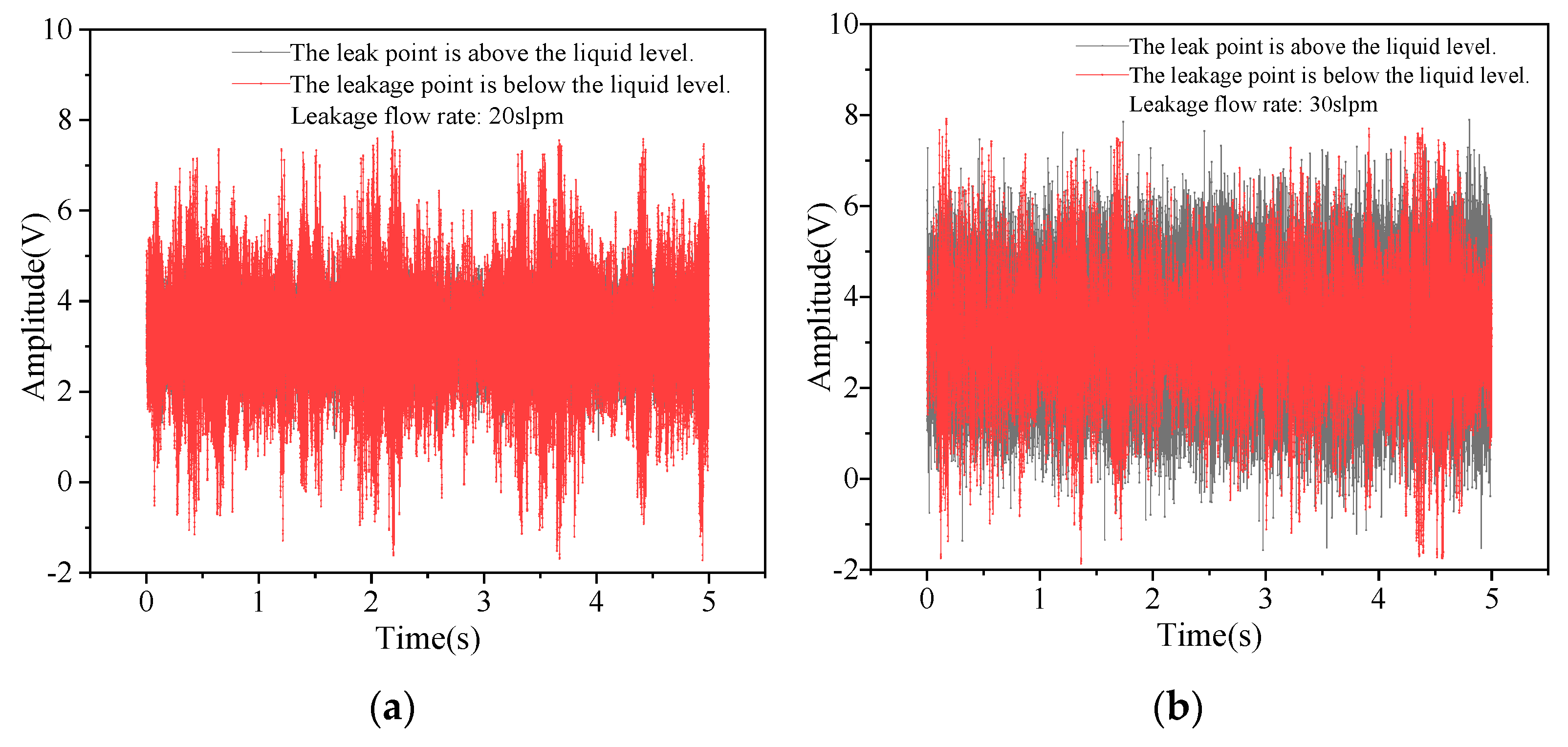


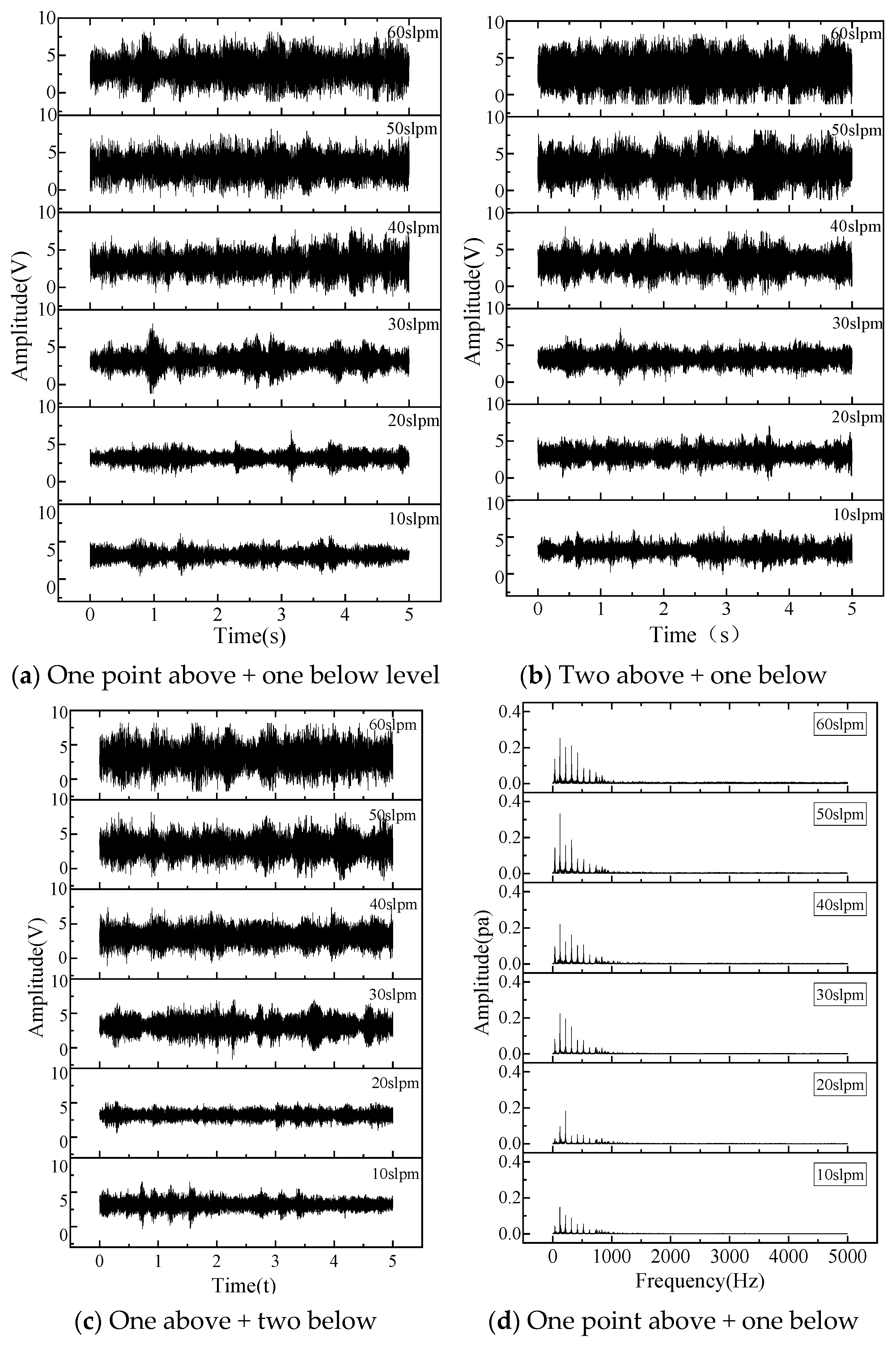


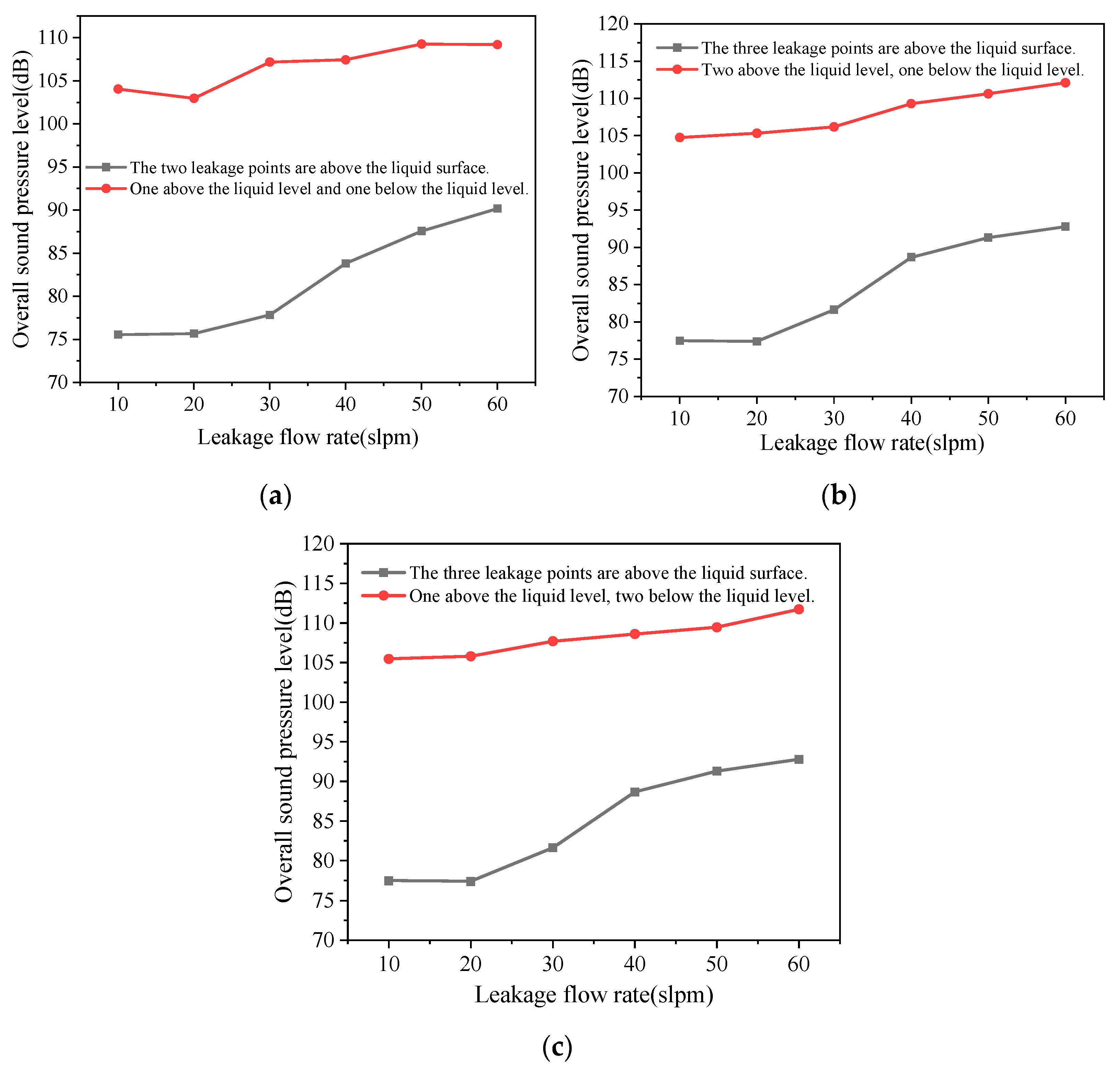
| Equipment Name | Technical Parameters | Equipment Name | Technical Parameters |
|---|---|---|---|
| Tubing | 3.5 inch, Φ88.9 mm × 6.54 mm | Data Acquisition Card | MCC1608 |
| Casing | Acrylic, Φ240 mm × 15 mm | Acoustic Sensor | CRY372 |
| Gas Flow Controller | Flow range: 0–500 SLPM; Accuracy: 0.3% F.S. | Air Pump | Rated pressure: 0.7 MPa; Capacity: 80 L |
| Filter Pressure Regulator | Output pressure: 0.05–0.7 MPa | Buffer Tank | Pressure rating: 1.5 MPa; Capacity: 300 L |
| Desiccant Filter | QPS-015 Triple-stage filtration | —— | —— |
| No. | Controlled Variable | Design Parameters |
|---|---|---|
| 1 | Leakage Aperture (mm) | 1, 2, 3, 4, 5 |
| 2 | Leakage Flow Rate (SLPM) | 0~140 |
| 3 | Number of Leakage Points | 1, 2, 3 |
| 4 | Leakage Position | Above and Below Liquid Level |
| 5 | Gas Medium | Compressed Air |
| 6 | Signal Sampling Frequency | 10 kHz |
Disclaimer/Publisher’s Note: The statements, opinions and data contained in all publications are solely those of the individual author(s) and contributor(s) and not of MDPI and/or the editor(s). MDPI and/or the editor(s) disclaim responsibility for any injury to people or property resulting from any ideas, methods, instructions or products referred to in the content. |
© 2025 by the authors. Licensee MDPI, Basel, Switzerland. This article is an open access article distributed under the terms and conditions of the Creative Commons Attribution (CC BY) license (https://creativecommons.org/licenses/by/4.0/).
Share and Cite
Yang, Y.-P.; Chu, S.-L.; Jing, Y.-H.; Sun, B.-C.; Zhang, J.-W.; Wang, J.-Y.; Fan, J.-C.; Li, M.-S.; Liang, S.; Zheng, Y.-S. Experimental Study on Simulated Acoustic Characteristics of Downhole Tubing Leakage. Processes 2025, 13, 1586. https://doi.org/10.3390/pr13051586
Yang Y-P, Chu S-L, Jing Y-H, Sun B-C, Zhang J-W, Wang J-Y, Fan J-C, Li M-S, Liang S, Zheng Y-S. Experimental Study on Simulated Acoustic Characteristics of Downhole Tubing Leakage. Processes. 2025; 13(5):1586. https://doi.org/10.3390/pr13051586
Chicago/Turabian StyleYang, Yun-Peng, Sheng-Li Chu, Ying-Hua Jing, Bing-Cai Sun, Jing-Wei Zhang, Jin-You Wang, Jian-Chun Fan, Mo-Song Li, Shuang Liang, and Yu-Shan Zheng. 2025. "Experimental Study on Simulated Acoustic Characteristics of Downhole Tubing Leakage" Processes 13, no. 5: 1586. https://doi.org/10.3390/pr13051586
APA StyleYang, Y.-P., Chu, S.-L., Jing, Y.-H., Sun, B.-C., Zhang, J.-W., Wang, J.-Y., Fan, J.-C., Li, M.-S., Liang, S., & Zheng, Y.-S. (2025). Experimental Study on Simulated Acoustic Characteristics of Downhole Tubing Leakage. Processes, 13(5), 1586. https://doi.org/10.3390/pr13051586





